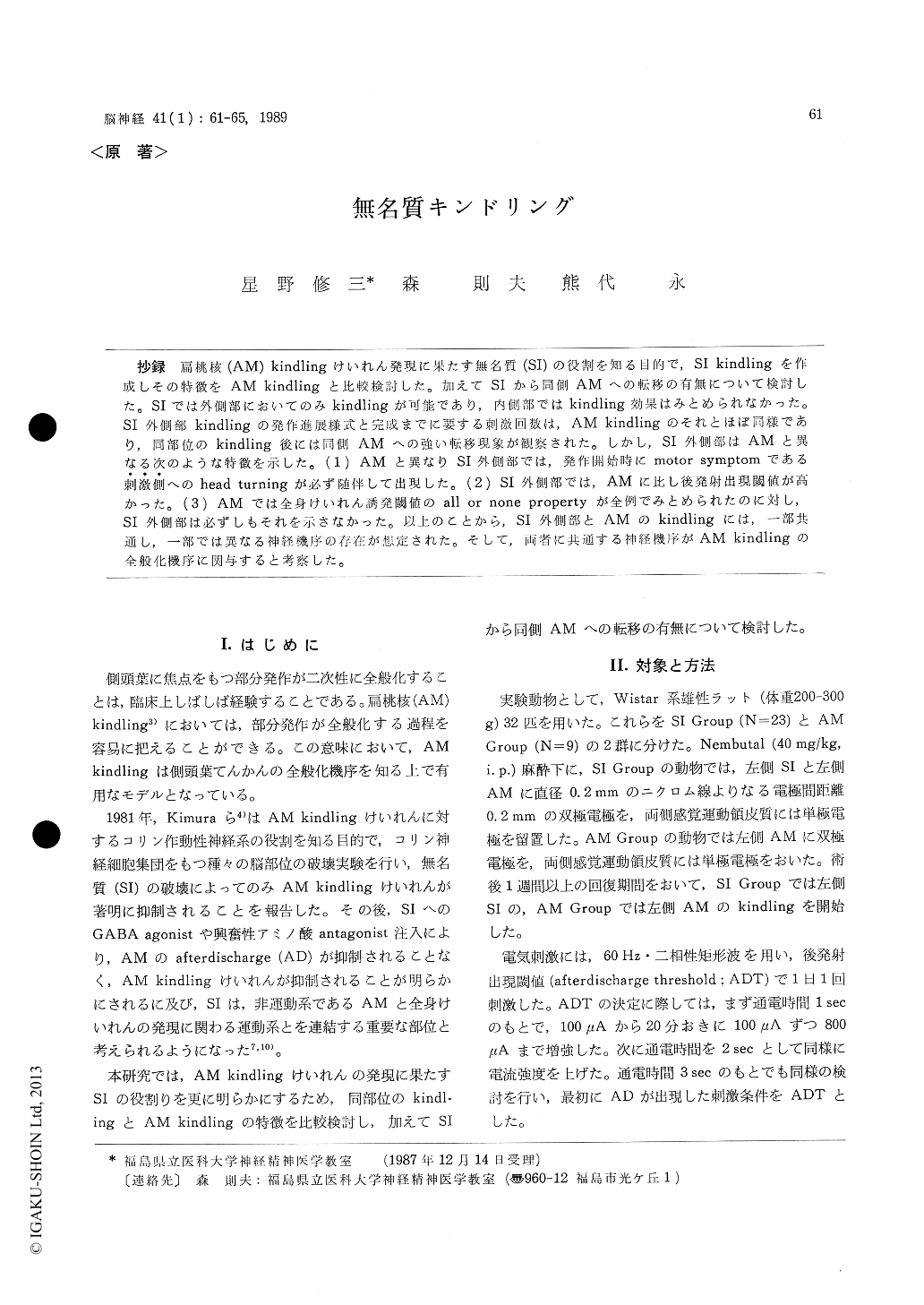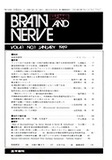Japanese
English
- 有料閲覧
- Abstract 文献概要
- 1ページ目 Look Inside
抄録 扁桃核(AM) kindlingけいれん発現に果たす無名質(SI)の役割を知る目的で,SI kindlingを作成しその特徴をAM kindlingと比較検討した。加えてSIから同側AMへの転移の有無について検討した。SIでは外側部においてのみkindlingが可能であり,内側部ではkindling効果はみとめられなかった。SI外側部kindlingの発作進展様式と完成までに要する刺激回数は,AM kindlingのそれとほぼ同様であり,同部位のkindling後には同側AMへの強い転移現象が観察された。しかし,SI外側部はAMと異なる次のような特徴を示した。(1) AMと異なりSI外側部では,発作開始時にmotor symptomである刺激側へのhead turningが必ず随伴して出現した。(2) SI外側部では,AMに比し後発射出現閾値が高かった。(3) AMでは全身けいれん誘発閾値のall or none propertyが全例でみとめられたのに対し,SI外側部は必ずしもそれを示さなかった。以上のことから,SI外側部とAMのkindlingには,一部共通し,一部では異なる神経機序の存在が想定された。そして,両者に共通する神経機序がAM kindlingの全般化機序に関与すると考察した。
With a combination of electrolytic lesion and choline acetyltransferase histochemistry, Kimura et al. suggested that cholinergic neurons in the sub-stantia innominata (SI) plays an important role in accessing non-motor structure, such as the amyg-dala (AM), to the motor system during AM kindl-ing. More recent studies demonstrated that intra-SI injection of GABAergic agent or excitatory amino acid antagonist suppresses the kindled gene-ralized convulsion without blocking afterdischarge (AD) generation in the AM.
In order to gain further insight into the role played by the SI in AM kindling, we examined the comparative electroclinical features of AM and SI kindling in addition to the transferability of the SI to the ipsilateral AM.
Male Wistar rats were electrically kindled at the left AM or the left SI at the AD threshold (ADT) until five consecutive Stage 5 generalized convul-sions were evoked. Subsequently, the stimulus in-tensity was gradually reduced and the last inten-sity to induce Stage 5 seizure was designated as the generalized seizure triggering threshold (GST). Following the determination of the GST, the SI stimulation was switched to the ipsilateral AM. All the animals were perfused and electrode place-ments were identified histologically.
The electrode placements distributed in the me-dial SI (N=5), lateral SI (N=9), Globus Pallidum(GP) (N=5) and Nucleus Accumbens (NA) (N=2). All electrodes of the AM (N=9) were located within the AM.
The 3/5 of GP rats kindled, while the 2/5 did not kindle. The 2/2 of NA rats kindled. Although the pattern of seizure development in both the GP and the NA rats was comparable with that of AM kindling, the GP rats showed contralateral head turning or circling as an initial symptom. The rate of kindling of both the GP and NA rats was relatively later than that of the AM rats.
The medial SI did not kindle at all, but all re-gions of the lateral SI kindled successfully. The pattern of seizure development observed in the lateral SI was strikingly reminiscent of AM kindl-ing, and the kindling rate of the lateral SI was similar to that of the AM. Moreover, when the AM was stimulated following the completion of SI kindling, all the animals responded with Stage 5 seizures upon the first stimulation. These findings suggest that both the SI and AM share common neurophysiological mechanismus during kindling. However, certain features between the SI and AM were different. For example, unlike the AM, the SI 1) developed ipsilateral head turning during Stage 1 masticatory movement, 2) had a generally higher DT than that of the AM, 3) produced more fragile GST and Stage 5 seizures. There-fore, it is reasonable to assume that the SI, espe-cially its lateral region, participates in but is not essential for AM seizure development.
Finally, this study emphasizes the importance of clinical awareness that automatism with ipsiversive motor seizure may have its origin in the SI.

Copyright © 1989, Igaku-Shoin Ltd. All rights reserved.


